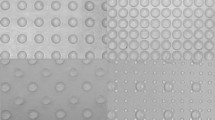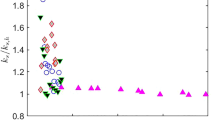Abstract
A previous paper from this laboratory presented measurements of turbulence that were made for water flowing over a wavy wall. The system was a 50 mm×600 mm rectangular channel for which the top wall was flat and the bottom wall was a train of sinusoidal waves with a wave length of 5 mm and a wave height of 0.50 mm. The Reynolds number, defined with the bulk velocity and the half-height of the channel, was 46,000. These conditions were such that a sand covered surface would be fully rough and characterized with a dimensionless sand roughness of k s +=104. The present paper presents measurements with Reynolds numbers of 11,000 and 3,200 for which the surface corresponds to the intermediate regime (k s +=22.4) and the hydraulically smooth regime (k s +=6.89). The measurements in the outer flow for k s +=22.4 differ from what is observed for k s +=104 in that the quadrant analysis of the Reynolds stress and the skewness coefficients for u i and v i are the same as found for flow over a flat boundary. Measurements of mean velocities, wall drag and turbulent intensities for k s +=6.89 are consistent with defining this surface as hydraulically smooth. Surprisingly the quadrant analysis of the Reynolds stress and measurements of the skewness factor for normal velocity fluctuations for k s +=6.89 are different from what is found for a flat surface. The contributions of quadrants 2 and 4 and their ratio are larger than what is found for a flat surface. Measurements for all three surfaces show smaller relative contributions for large wavenumber fluctuations. However, this is much more pronounced for k s +=6.89 and k s +=22.4.






















Similar content being viewed by others
References
Benjamin TB (1959) Shearing flow over a wavy boundary. J Fluid Mech 6:161–205
Floryan JM (1997) Stability of wall-bounded shear layers in the presence of simulated distributed surface roughness. J Fluid Mech 335:29–55
Günther A, Papavassiliou DV, Warholic MD, Hanratty TJ (1998) Turbulent flow in a channel at a low Reynolds number. Exp Fluids 25:503–511
Hoyt JW, Sellin RHJ (2000) A comparison of tracer and PIV results in visualizing water flow around a cylinder close to the free surface. Exp Fluids 28:261–265
Ligrani PM, Moffat RJ (1986) Structure of transitionally rough and fully rough turbulent boundary layers. J Fluid Mech 162:69–98
Nakagawa S, Na Y, Hanratty TJ (2003) Influence of a wavy boundary on turbulence. I. Highly rough surface. Exp Fluids (in press)
Schlichting H (1979) Boundary-layer theory, 7th edn. McGraw-Hill, New York
Warholic MD (1997) Modification of turbulent channel flow by passive and additive devices. PhD thesis, University of Illinois
Teitel M, Antonia RA (1991) Comparison between a turbulent boundary layer and a turbulent duct flow. Exp Fluids 11:203–204
Zilker DP, Hanratty TJ (1979) Influence of the amplitude of a solid wavy wall on a turbulent flow. Part 2. Separated flows. J Fluid Mech 90:257–271
Acknowledgement
This work was supported by the National Science Foundation under Grant NSF CTS 98–06265.
Author information
Authors and Affiliations
Corresponding author
Rights and permissions
About this article
Cite this article
Nakagawa, S., Hanratty, T.J. Influence of a wavy boundary on turbulence.. Exp Fluids 35, 437–447 (2003). https://doi.org/10.1007/s00348-003-0682-1
Received:
Accepted:
Published:
Issue Date:
DOI: https://doi.org/10.1007/s00348-003-0682-1




